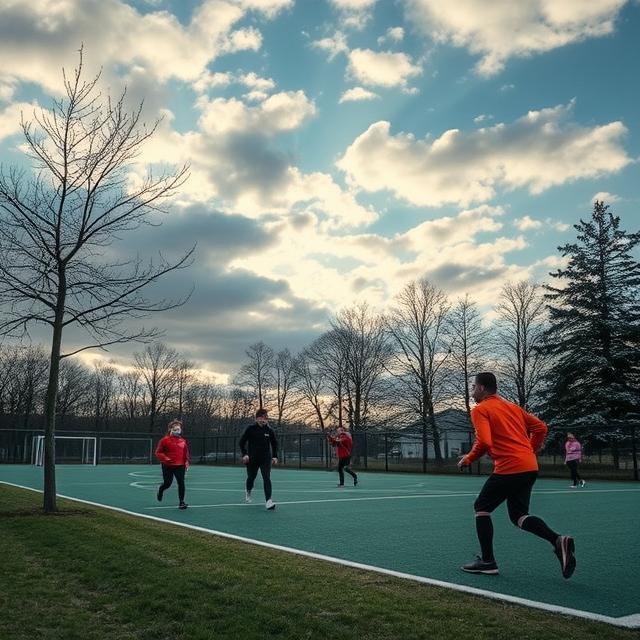The speeding severity of climate change is now making its marks on the global sports ecosystem. From prolonged heat waves to unpredictable storms, the increased climate directly impacts outdoor sports clubs and outdoor sports facilities. Whereas green activists have been making worldwide warnings, right from the early days, the sports world is now starting to see live impacts of rising temperatures, altered climatic patterns, and ecological damage. It has been a challenge, and now a necessity, for sports fans, organizers, and athletes to cope with this new phenomenon.
Weather Volatility and Scheduling Disruptions
The most direct impact of climate change on outdoor sports clubs is the disturbance of the cyclical pattern. Rain used to fall in predictable patterns but now comes in unpredictable bursts. Soccer, cricket, tennis, and athletics sports are most often exposed to delays or cancellations caused by surprise storms or blistering heat.
This unpredictability is administrative nightmares for the clubs that are organizing tournaments and training sessions. With no reliable window of play, clubs have to overbook pitches, lose revenue from the cancellation of events, and pay for weather forecast services in an attempt to be able to schedule. These issues have a major impact on the sustainability and finance planning of community-based and elite outdoor sports groups.
Physical Impact on Sports Facilities
Extensive use and strong weather conditions are likely to affect outdoor sports facilities like football pitches, tennis courts, and running tracks. UV light for extended periods weakens manufactured grass and equipment, while too much rain causes floods on pitches and weakens constructions.
Most of the outdoor sports facilities constructed decades ago did not incorporate robust elements that are effective under the present conditions. Surfaces turn rough due to heat stress, and grounds that were waterlogged for weeks become useless. Keeping up with these facilities now takes more resources, sophisticated drainage systems, heat-reducing materials, and constant maintenance.
Climate-proofing their premises is a budgetary burden on small clubs with limited budgets. Without significant investment or government support, it’s a risk to the survival or the movement of some clubs.
Health and Safety Concerns for Athletes
Climate change also brings additional impacts on health. Increasing heat and humidity threaten people with heat exhaustion, dehydration, and other heat-related complications. Where summer outdoor play had previously been safe, there are now increasing calls to limit training sessions or play games during early morning or evening hours.
Furthermore, air quality degraded in most cities through heightened temperatures and wildfire smoke, affecting breathing and overall performance. Therefore, it follows that outdoor sports associations have to revise health protocols on a regular basis and incorporate climate-based safety considerations.
The athletes are more and more offered cooling equipment, hydration techniques, and gear to check physical stress under poor climate conditions. They are not, however, always accessible to grassroots or young clubs with low access to high-end facilities.

How Climate Change Affects Outdoor Sports Clubs and Facilities
Strategic Adaptation and Sustainability Measures
Visionary sports clubs and facility owners are opting for resilience and sustainability. Others have opted for green infrastructure, such as solar panels, water harvesting systems, and natural cooling features. Low-carbon pitch, LED lighting, and climate-sensitive landscaping are becoming the norm in outdoor sports facilities.
Along with physical upgrades, clubs are now requesting policy reforms. Most are requesting green awareness in league policies, requesting emissions audits, carbon offset schemes, and environmentally-friendly standards. What they aim for is a lower environmental impact of their own while conforming to climate pressures.
Collaboration with environmental NGOs and local authorities also assists clubs in remaining ahead of policy changes and accessing funds for sustainable reform. All these forward-thinking strategies are key to maintaining outdoor sports clubs and opening them up to future generations.
Education and Community Engagement
Aside from infrastructure, climate awareness is also increasing in prominence. Most of the external sporting facilities now have outreach programs that educate players, coaches, and spectators on sustainability. They also have tree-planting programs, zero-waste campaigns, and carbon footprint-reduction workshops for sporting events.
By integrating climate literacy into the culture of sports, sport clubs not only promote environmental awareness but enable their members to be change makers. With climate change still in progress, this change in outdoor sports clubs culture is critical to resilience and sustainability in the long run.
Climate change disrupts outdoor sports clubs and destroys outdoor sports facilities, driving the sports community to adapt with sustainability and safe strategies.
The Integration of AR in Stadium Fan Engagement and Sports Strategy
The Rise of AI Umpires in Baseball and Competitive Sports Center



